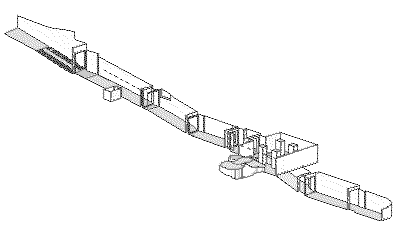![]()
Valley of the Kings - KV10
tomb of Amenemose - XIXth Dynasty
|
Because the tomb of Amenemose seems to have lain open since antiquity, several classical graffiti are present in the entrance area, together with Arabic inscriptions. The current excavations have shown that the passages slope considerably less than had been thought; indeed, the fourth passage immediately beyond the well room is virtually horizontal, showing that the more level design first attested in KV7 was also used in the monument. No shaft was cut in the well room (F), but the side room found in all major tombs since Seti I was partially cut on the west side of the pillared hall. Beyond this point the tomb appears to end in a roughly vaulted passage adapted as a burial chamber (K). In the tomb were found a fragment of limestone sarcophagus, fragmentary ushabti figures of Seti I, sarcophagus fragments of Ramesses VI, fragments of alabaster and limestone canopic jars and box and part of red granite sarcophagus lid, inscribed for Takhat, king's mother, was probably buried in the tomb. Mummy of king Amenemose is not identified. |
|
|
|
 |
| A - descending ramp with
steps B - descending corridor with small niche (scenes from Litany of Re, king before Re-Horakhty at entrance) C - corridor (scenes from Litany of Re) D - corridor (scenes from the Amduat) E - doorkeeper's niches F - the well (scenes of the Takhat offering before deities) G - ramp H - pillared hall (Baketwerel, wife of king, offering before deities; scenes from the Book of the Dead) I - KV11 originally broke through roof here J - corridor K - corridor used as burial chamber
|
|
![]()
|
Copyright © 2000-2013 Dariusz Sitek, Czestochowa - Chicago - Ann Arbor |